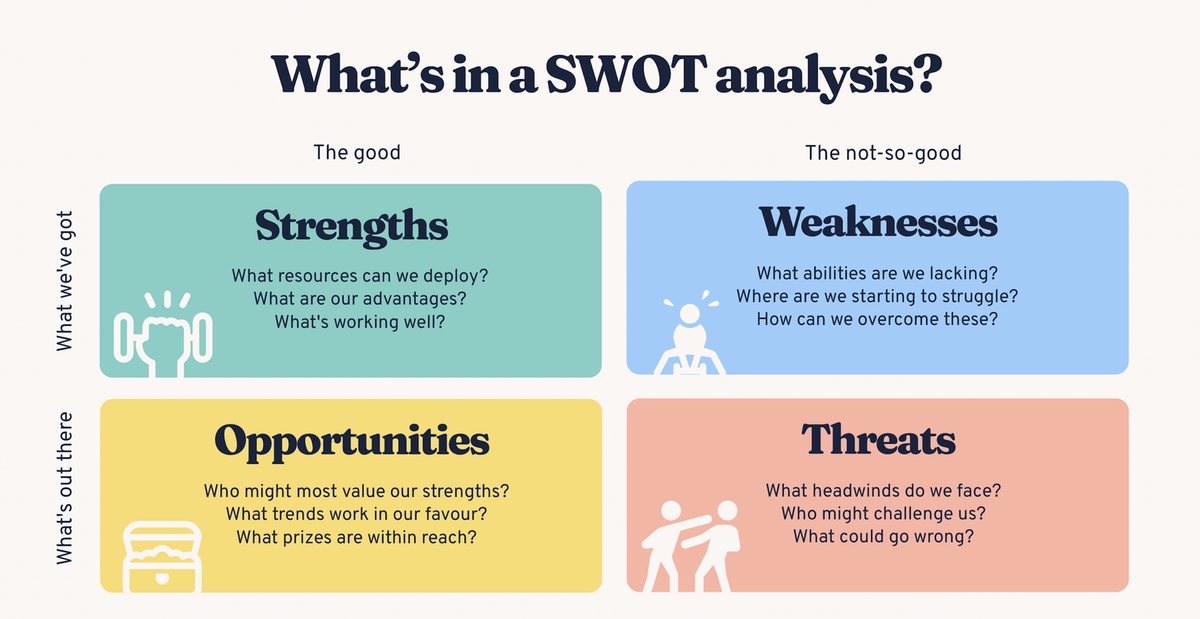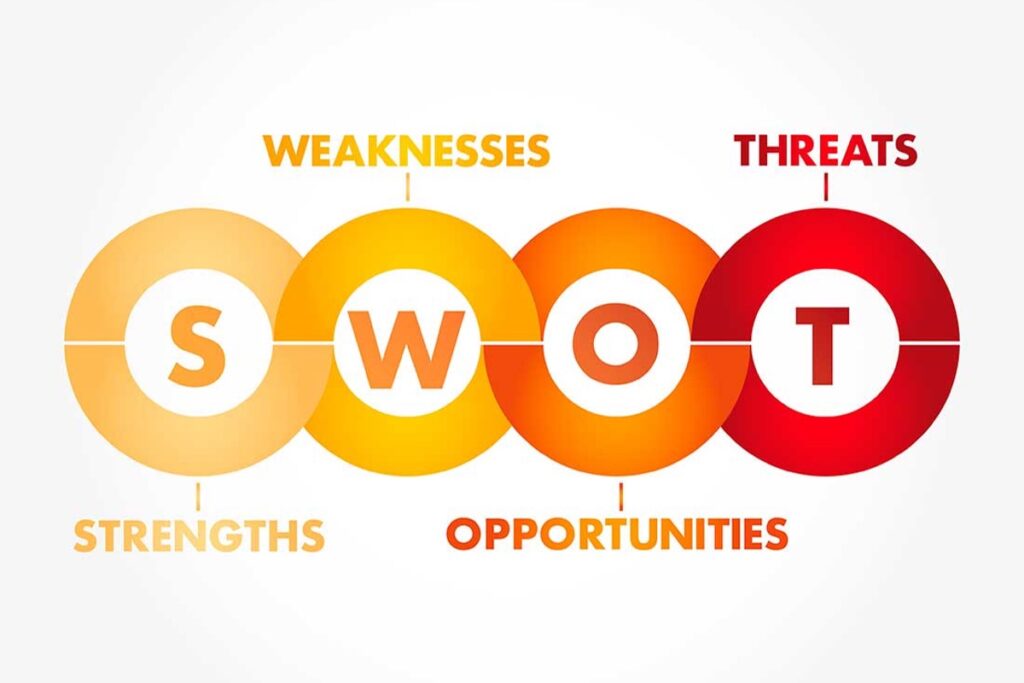Life constantly forces us to make decisions. Every choice we make, in one way or another, influences our future. Some decisions can determine our fate for years, even decades. To make any important decision—whether in business or everyday life—we need thorough analysis.
But quality analysis is no easy task. Despite its importance, it’s something we’re rarely taught, even though it’s a vital management function that everyone should master. Today, let’s explore one of the most widely used analysis methods: SWOT analysis.
What Is SWOT Analysis?
SWOT analysis is a method for the initial assessment of a current situation, based on examining it from four angles:
- Strengths – internal advantages
- Weaknesses – internal disadvantages
- Opportunities – external positive factors
- Threats – external negative factors
Strengths and weaknesses refer to your internal environment—what you currently possess and control. Opportunities and threats refer to the external environment—they may or may not occur and often depend on your actions and decisions.
The term SWOT was first introduced at a Harvard conference on business policy in 1963 by Professor Kenneth Andrews. In 1965, SWOT analysis was proposed as a tool for developing corporate strategy.
SWOT analysis helps structure a clear description of a situation, allowing sound and balanced decisions. It plays a vital role in the management cycle and should be mastered by anyone involved in human resource management or marketing.
Rules for Conducting a SWOT Analysis
Before starting a SWOT analysis, it’s important to follow a few basic rules:
- Define a specific research area. If it’s too broad, conclusions will be vague and hard to apply.
- Clearly separate the four SWOT components. Don’t confuse strengths with opportunities. Strengths and weaknesses are internal factors under your control. Opportunities and threats are external and largely outside your control.
- Avoid subjectivity. Just because you think your product is unique doesn’t make it so—ask the market. Your personal opinion is irrelevant without customer validation.
- Gather diverse perspectives. The larger the input pool, the more accurate the findings. Beware of the “survivorship bias.”
- Use specific, precise language. For example, saying “work harder to earn more” is vague. Define concrete actions, timelines, and responsibilities.
Once these guidelines are understood, you can start creating your SWOT matrix.
The SWOT Matrix
SWOT analysis is often visualized in a simple table, known as the SWOT matrix. Its format is adaptable to any type of decision—from weekend plans to multimillion-dollar investments.
A standard SWOT matrix looks like this:

You don’t need to label rows and columns if you’re already familiar with the method, but it helps with clarity.
How to Use SWOT Analysis
You’re facing a decision and need a solution. Start by drawing a SWOT matrix, dividing a sheet of paper into four quadrants. Fill each section with as much relevant information as possible—starting with the most important factors.
Analyzing Strengths and Weaknesses
Surprisingly, many beginners struggle most with identifying strengths. You can ask for input from colleagues or friends, but learning to self-assess is invaluable.
In business, strengths often include:
- Uniqueness of your product or service
- Human resources: employee competence and experience
- Clear business processes and operational clarity
- Financial stability and access to capital
- A well-structured sales department
- Thoughtful marketing strategy
- Low production costs
For personal SWOT analysis, consider:
- Education and knowledge
- Skills and experience
- Social connections and influence
- Recognition and authority
- Material resources
Focus on what you enjoy and do well. Typically, we perform poorly at things we dislike.
Analyzing Opportunities and Threats
These stem from external changes or actions you can take. Analyzing markets and predicting trends requires experience and data. It’s tough to forecast the future, so always rely on current facts and trends, but also consider worst-case scenarios in long-term planning.
Key business-related factors include:
- Market trends (rising or falling demand)
- Economic conditions in the country
- Competition (a new major player can disrupt your industry)
- Infrastructure changes (can help or hurt your business)
- Legal and political changes (e.g., all casinos in Russia were shut down in 2009)
- Technological shifts (some industries disappear, others are born)
You can consult industry experts to enhance the quality of your SWOT analysis.
SWOT Analysis Methodology
Once your matrix is filled out, the next step is to build an action plan:
- Rank all factors by their impact level
- Eliminate minor or imaginary factors
- Identify how strengths can help seize opportunities or neutralize threats
- Analyze how weaknesses could limit your opportunities or worsen threats
- Look for ways strengths can compensate for weaknesses
- Develop ways to reduce or mitigate threats
Based on this process, define your core development strategies.
SWOT is a descriptive tool, not a data-driven one. It doesn’t include big data analysis or performance comparisons over time, and it doesn’t measure parameters quantitatively. That’s why SWOT is inherently subjective—but still extremely useful.
Applications of SWOT Analysis
SWOT’s simplicity makes it a universal tool. It can be used in both personal life and business. It works independently or in combination with other analytical methods. It’s most widely used in marketing and management, especially for strategic planning.
Personal SWOT Analysis
SWOT is also great for personal development. Use it to set career goals or even relationship priorities.
I highly recommend that mid- and senior-level managers ask their team members to perform personal SWOT analysis at least once a year. It’s also a great tool for hiring—for assessing leadership potential during interviews. I first saw this idea in Igor Mann’s book Number 1, where he suggests giving the SWOT task to every job candidate.
In conclusion, SWOT analysis is a practical and versatile tool that helps individuals and organizations make better decisions, set meaningful goals, and develop actionable strategies based on a structured understanding of both internal and external factors.




